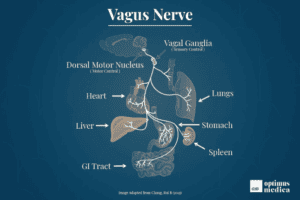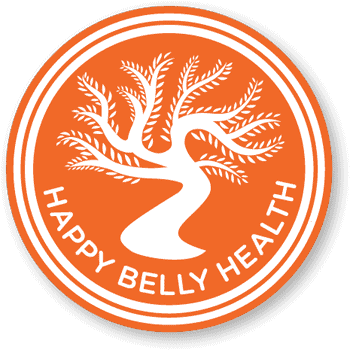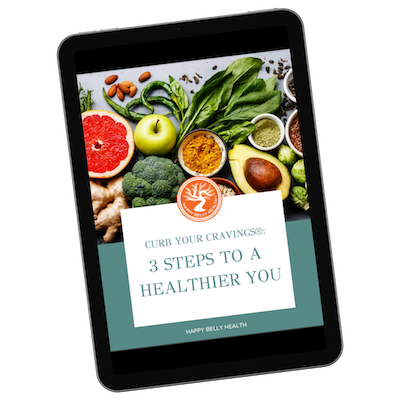The longest cranial nerve of our parasympathetic nervous system, the vagus nerve (VN), branches off into two, and traverses its way throughout our body. It innervates major organs, glands, and blood vessels, and controls a few skeletal functions, such as the muscles of our face, digestive tract, inner ear, and larynx. Since approximately 90% of its nerve fibers are afferent, which go from the body To the brain, the vagus nerve is primarily relaying information to the brain about the state of our internal environment. Stimulation of afferent fibers in the gut influences brain systems that play a key role in regulating mood. Some of the connections between IBS and anxiety, for example, can be understood via the communication between the vagus nerve and the gut’s enteric nervous system. Stimulation of the vagus nerve is one technique that may be used to mitigate IBS symptoms.

The vagus nerve can be thought of as a super highway that connects the emotional, physical, mental, and spiritual aspects of ourselves. The vagus nerve, gut, and heart work together to coordinate our emotions. When our vagal tone is healthy, it will bring us back to equilibrium after a stressful experience. However, when instead our sympathetic nervous system is primed for fight, flight, or hide responses, one may be unable to detect safety and can get stuck in a trauma response where defenses are still engaged, even after the threat is gone.
Maladaptive behaviors are unique to each individual. Some may experience numbness in the body, others a hypervigilant need to “keep moving”. It can also make one more vulnerable to misreading the cues of others. We can help people understand that their reflexive state is the body’s heroic attempt to protect, and keep them alive.
We can prime the vagus nerve by convincing the body that it is safe by giving it cues of trust and safety in our environment. When we know we have a choice to work with our body, we can recontextualize our inner narrative from one of victim to one of empowerment, increasing our resilience to stress.
- Make your exhales longer than your inhales. Quick exhalations activate the sympathetic nervous system. Slow exhalations, however, cause the vagus nerve to secrete acetylcholine, a neurotransmitter which binds to receptors in the heart, slowing it.
Our breath is both an involuntary and voluntary action that is free and accessible anytime, anywhere. We can utilize this powerful healing technique in line at the grocery store, while driving, cooking, getting dressed, etc. Singing, humming, chanting, and playing a wind instrument all restore vagal tone with long, slow exhalations.
- The vagus nerve connects to your larynx, which controls swallowing, breathing, and sound. Singing, humming, chanting, and playing a wind instrument activate the vagus nerve by stimulating all three of these functions. You can pay attention to the tones you use when speaking as well. Find a speaking tone that is soothing to you, and especially use it when
- Don’t perseverate on the story, rather befriend your nervous system. Ask yourself, what am I feeling in this moment, and where do I feel it in my body? Put your hands there. Breathe into that space with long Relax the muscles in your face, shoulders, and pelvic floor.
Visualizations of safety dissipate feelings of threat. Now, think of a time you felt safe, calm, happy, or joyful. Even if it was just a moment. Visualize/describe/recreate every detail of that moment. Immerse yourself in the visualization and allow the feelings to flood your body, still breathing into your body with slow exhalations. Allow the visualization of your “safe space” to remain front and center in your conscious mind throughout the day, and know you can activate your parasympathetic nervous system by returning to it whenever you choose.
- Inquire
- Could I be having a vagal reaction to a current situation due to a learned emotional response from my past?
- What “need” do I have that’s not being met? How can I articulate it so I will be heard?
- Our thoughts directly influence our biochemistry!
- What thoughts are floating through my head today?
- What experiences or conversations have I had today that may be affecting my mood?
- Again, stay out of the story. Use this as an opportunity to identify toxic thoughts, relationships, or conversation topics so you can consciously and appropriately Choose a different way to create a different
- Sometimes when we ask for a miracle, what we get is a change in
- What is my belief? Does this belief serve me?
- Who would I be, and how would my environment feel safer if I had a different belief/perspective?
- Gratitude gives the body cues of safety – Don’t tell, rather show your body you are safe by using as much detail as possible to describe how grateful you
- What colors, sounds, sensations, textures, feelings, etc are associated with my gratitude?
- Taking responsibility for how we show up does not mean we are bad or shameful. It means we can own, and learn from our imperfections, and then shift into a healthier state of
- What part do I need to take responsibility for?
- Am I taking responsibility for something that does not belong to me?
- Forgiveness does not mean we condone what happened. It means we accept (and can even be grateful for) the lessons that came with the experience and choose to move forward and be
- What would it look like to have a deeper level of understanding and compassion for myself or another right now?
- What would it feel like to forgive myself or another right now?





